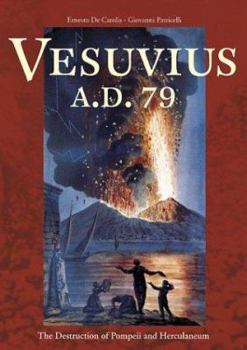Vesuvius, A.D. 79: The Destruction of Pompeii and Herculaneum
Select Format
Select Condition 
Book Overview
Now available in English, this book tells the story of the eruption of Vesuvius and the destruction of the cities of Pompeii and Herculaneum from a combined volvanological and archaeological... This description may be from another edition of this product.
Format:Hardcover
Language:English
ISBN:0892367199
ISBN13:9780892367191
Release Date:November 2003
Publisher:Oxford University Press, USA
Length:135 Pages
Weight:1.35 lbs.
Dimensions:0.6" x 6.6" x 10.3"
Related Subjects
Ancient Earth Sciences Earthquakes & Volcanoes History Nature Rome Seismology Social Science Social SciencesCustomer Reviews
3 ratings
Vesuvius in detail
Published by Thriftbooks.com User , 16 years ago
This is a very nice little book on the subject. It would make a particularly useful pre-attendance read for the Pompeii exhibit currently making the rounds of science museums. The authors give a nice overview of the mechanics of volcanism for those who have no background on the topic, discussing the "design" of volcanoes, the chemical make up and physical behavior of their magmas, the effects of sudden introduction of water during eruption, and so on. Schematic diagrams show internal workings of the phenomenon, and volcanoes other than Vesuvius are used as models of the various types of eruption. Better still are the photos of modern recently active volcanoes in these genre used to dramatically illustrate these eruptive behaviors. The latter bring the ancient event at Vesuvius and its impact on the residents of Pompeii and Herculaneum much more vividly to mind. Although some of the terminology may confuse the beginner, there is a short vocabulary of terms at the end of the book that should be helpful. The descriptions of the various types of volcanoes and their behavior were very lucid, but I was a little disappointed by the authors' failure to place volcanism into a plate tectonics landscape. This underlying theory makes location and type of activity more apparent and understandable. Placing Vesuvius in geologic context would have clarified its place among volcanoes world wide, which would have been more thorough. I was pleased especially with the comprehensive discussion of the history of Vesuvius' activity, particularly its earliest which is less often presented in works on the volcano. The fact that it is the "gasket" for a much larger magmatic region which includes the Bay of Naples is definitely a fact not to be overlooked. There is an island just off the coast that emerges and submerges periodically because of it and the region around Naples exhibits a periodic and substantial rise and fall in elevation and even fumarole activity in some places. In short the region behaves rather like Yellowstone National Park, which also rests over a very large magmatically active ancient volcano. The discussion of the eruption of Vesuvius in 79 AD is the focus of the book, and it is very thorough. I had known from my study of ancient history that the event was described in some detail by Pliny the Younger in a pair of letters describing his uncle's death (the senator and natural scientist Pliny the Elder who died near Pompeii attempting to rescue people fleeing from the area) for a family friend. I was also familiar with the heart wrenching plaster casts of some of the victims at Pompeii that have been discovered over the years and with the forensic information from the skeletal remains found at Herculaneum. That so much was known about the actual geologic sequence of events was more of a surprise. The authors give a "blow by blow" description of the eruption and of people`s reactions to it, drawing from historical information, arc
Vesuvius for the layman
Published by Thriftbooks.com User , 18 years ago
if you are interested in the geology of what happened in 79AD, this book is for you. With pictures of modern volcanic eruptions, the authors take you step by step through the cataclym that buried Pompeii and Herculaneum. Reading more artsy oriented books about Pompeii, i wondered: How come there are paster casts of the dead victims from pompeii and just skeletons from herculaneum? How come Pompeii is bured in ash/pumice and Herculaneum is buried in hard rock? how come the sea receeded during the eruption? How much of Harris's Novel Pompeii is taken from life/scientific evidence. This not so long book answered a lot of these questions for me. Even the black and white photos were impressive: ie how did the person that took this photo managed to survive this?
A riveting, in-depth account
Published by Thriftbooks.com User , 20 years ago
Full-color photographs and illustrations bring to life the scholarly yet vivid text comprising Vesuvius A.D. 79: The Destruction Of Pompeii And Herculaneum. by Ernesto De Carolis (Director of the Restoration Laboratories at the Archaeological Superintendency of Pompeii) and Giovanni Patricelli (vulcanologist and Vesuvius seismological topography expert) successfully collaborate to bring the reader a riveting, in-depth account of a terrible volcanic eruption that brought cataclysm to the people of ancient Pompeii and Herculaneum. Exploring in detail the events leading up to, during, and after the terrible eruption, Vesuvius A.D. 79 is a compelling and very highly recommended "window" into a unique and revealing event in the study of Roman history.




